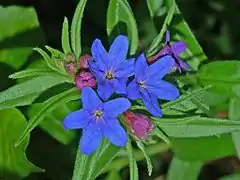Lithospermum purpurocaeruleum
Lithospermum purpurocaeruleum, the purple gromwell,[1] is a herbaceous perennial rhizomatous plant of the genus Lithospermum, belonging to the family Boraginaceae.
| Lithospermum purpurocaeruleum | |
|---|---|
 | |
| Scientific classification | |
| Kingdom: | Plantae |
| Clade: | Tracheophytes |
| Clade: | Angiosperms |
| Clade: | Eudicots |
| Clade: | Asterids |
| Order: | Boraginales |
| Family: | Boraginaceae |
| Genus: | Lithospermum |
| Species: | L. purpurocaeruleum |
| Binomial name | |
| Lithospermum purpurocaeruleum | |
| Synonyms | |
| |
Etymology
The Latin name of the species purpurocaeruleum means purple and blue, referred to the changing colour of the flowers with the progress of flowering.
Description

Lithospermum purpurocaerula is a bushy plant that reaches on average 20–60 centimetres (7.9–23.6 in) of height, with a maximum of 70 centimetres (28 in). The stem is hairy, erect and unbranched. Leaves are dark green and lanceolate to narrow elliptic, with a prominent midrib on the underside. Flowers are hermaphroditic, funnel-shaped, 15–20 millimetres (0.59–0.79 in) long and 10–15 millimetres (0.39–0.59 in) of diameter, clustered in a racemose inflorescence. The blossoms are purple-reddish, then the color of the flowers turns into a deep blue. The flowering period extends from April to June. The fruits are bright white capsules, 4–5 millimetres (0.16–0.20 in) long, with a glossy surface. They are very hard (hence the genus synonym Lithospermum, meaning "stone seed" for the hardness of these capsules).
Distribution
This species is widespread in British Isles, in central Europe up to South Russia and in Mediterranean countries from Spain to the eastern Turkey.
Habitat
Lithospermum purpurocaeruleum is typically found in dry and warm forests with sparse deciduous vegetation, in the meadows on the edge of the wood, in hedgerows and scrublands. The plants prefer calcareous soils rich in humus, at an altitude of 0–1,800 metres (0–5,906 ft) above sea level.
Uses
Before the introduction of synthetic dyes to Meiji period Japan, the roots of lithospermum purpurocaeruleum were commonly used as a dyestuff for luxury textiles, typically high-end kimono and obi. The process of extracting purple dyestuff from the roots was an exceedingly long, complex and time-consuming process, necessitating its relatively high expense:
The roots [of the plant] are collected and dried for two to three months to mature the color. While this occurs, the silk is pre-mordanted...the mordanting process involves repeated immersion of the cloth or yarn in the alum bath and drying over a two- ir three-month period. To prepare the dyestuff, the gromwell roots are softened overnight in 60°[celsius] water and then pounded to release the dye. The silk is then repeatedly immersed in the bath, aired to allow more oxygen to penetrate the cloth and then steeped in the dye until the desired color is achieved. When the dyeing is completed the cloth is placed in dark storage for as long as a year while the color continues to mature.[2]
The resulting shades of purple produced by lithospermum purpurocaeruleum were referred to as "murasaki", a name taken from the author of The Tale of Genji, Murasaki Shikibu. Additional terms were used for specific shades of purple within this range, particularly during the Heian period; names such as "usuki murasaki" ("pale purple") and "asaki murasaki" ("light purple") formed important distinctions when dressing in specifically-layered clothing, and could also indicate (typically high) rank.[3]
References
- "BSBI List 2007". Botanical Society of Britain and Ireland. Archived from the original (xls) on 2015-01-25. Retrieved 2014-10-17.
- Parmal, Pamela A. (2004). "The Impact of Synthetic Dyes on the Luxury Textiles of Meiji Japan" (pdf) (Symposium Proceedings (474)). Textile Society of America. Archived from the original on 21 July 2020. Retrieved 21 August 2020.
- Bryant, Anthony J. "Kasane no Irome". Sengoku Daimyo. Archived from the original on 21 August 2020. Retrieved 21 August 2020.
- Pignatti S. - Flora d'Italia – Edagricole – 1982, Vol. II, pag. 398
- Tutin, T.G. et al. - Flora Europaea, second edition - 1993
External links
 Media related to Aegonychon purpurocaeruleum at Wikimedia Commons
Media related to Aegonychon purpurocaeruleum at Wikimedia Commons Data related to Buglossoides purpurocaeruleum at Wikispecies
Data related to Buglossoides purpurocaeruleum at Wikispecies